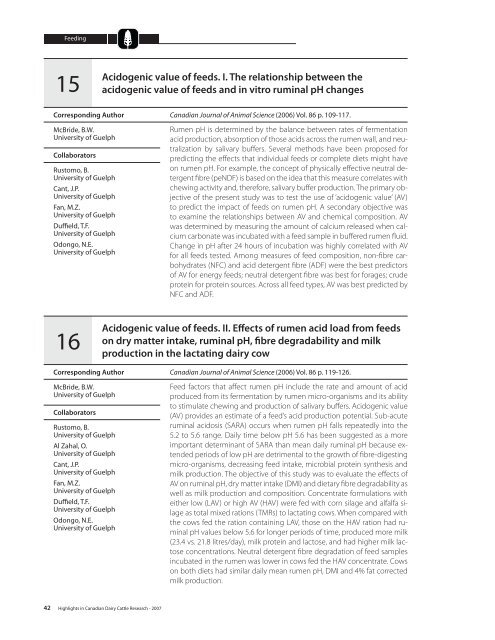A52-75-2007E.pdf - AgroMedia International Inc
A52-75-2007E.pdf - AgroMedia International Inc
A52-75-2007E.pdf - AgroMedia International Inc
You also want an ePaper? Increase the reach of your titles
YUMPU automatically turns print PDFs into web optimized ePapers that Google loves.
Feeding15Acidogenic value of feeds. I. The relationship between theacidogenic value of feeds and in vitro ruminal pH changesCorresponding AuthorMcBride, B.W.University of GuelphCollaboratorsRustomo, B.University of GuelphCant, J.P.University of GuelphFan, M.Z.University of GuelphDuffield, T.F.University of GuelphOdongo, N.E.University of GuelphCanadian Journal of Animal Science (2006) Vol. 86 p. 109-117.Rumen pH is determined by the balance between rates of fermentationacid production, absorption of those acids across the rumen wall, and neutralizationby salivary buffers. Several methods have been proposed forpredicting the effects that individual feeds or complete diets might haveon rumen pH. For example, the concept of physically effective neutral detergentfibre (peNDF) is based on the idea that this measure correlates withchewing activity and, therefore, salivary buffer production. The primary objectiveof the present study was to test the use of ‘acidogenic value’ (AV)to predict the impact of feeds on rumen pH. A secondary objective wasto examine the relationships between AV and chemical composition. AVwas determined by measuring the amount of calcium released when calciumcarbonate was incubated with a feed sample in buffered rumen fluid.Change in pH after 24 hours of incubation was highly correlated with AVfor all feeds tested. Among measures of feed composition, non-fibre carbohydrates(NFC) and acid detergent fibre (ADF) were the best predictorsof AV for energy feeds; neutral detergent fibre was best for forages; crudeprotein for protein sources. Across all feed types, AV was best predicted byNFC and ADF.16Acidogenic value of feeds. II. Effects of rumen acid load from feedson dry matter intake, ruminal pH, fibre degradability and milkproduction in the lactating dairy cowCorresponding AuthorMcBride, B.W.University of GuelphCollaboratorsRustomo, B.University of GuelphAl Zahal, O.University of GuelphCant, J.P.University of GuelphFan, M.Z.University of GuelphDuffield, T.F.University of GuelphOdongo, N.E.University of GuelphCanadian Journal of Animal Science (2006) Vol. 86 p. 119-126.Feed factors that affect rumen pH include the rate and amount of acidproduced from its fermentation by rumen micro-organisms and its abilityto stimulate chewing and production of salivary buffers. Acidogenic value(AV) provides an estimate of a feed’s acid production potential. Sub-acuteruminal acidosis (SARA) occurs when rumen pH falls repeatedly into the5.2 to 5.6 range. Daily time below pH 5.6 has been suggested as a moreimportant determinant of SARA than mean daily ruminal pH because extendedperiods of low pH are detrimental to the growth of fibre-digestingmicro-organisms, decreasing feed intake, microbial protein synthesis andmilk production. The objective of this study was to evaluate the effects ofAV on ruminal pH, dry matter intake (DMI) and dietary fibre degradability aswell as milk production and composition. Concentrate formulations witheither low (LAV) or high AV (HAV) were fed with corn silage and alfalfa silageas total mixed rations (TMRs) to lactating cows. When compared withthe cows fed the ration containing LAV, those on the HAV ration had ruminalpH values below 5.6 for longer periods of time, produced more milk(23.4 vs. 21.8 litres/day), milk protein and lactose, and had higher milk lactoseconcentrations. Neutral detergent fibre degradation of feed samplesincubated in the rumen was lower in cows fed the HAV concentrate. Cowson both diets had similar daily mean rumen pH, DMI and 4% fat correctedmilk production.42 Highlights in Canadian Dairy Cattle Research - 2007





